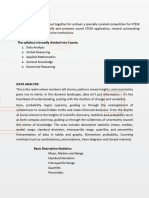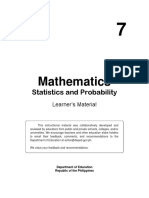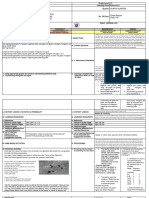ESF Data Handling August 2013
Uploaded by
Stu LoweESF Data Handling August 2013
Uploaded by
Stu LoweESF Data Handling
Phase 1 K1 K2 Year 1 Phase 2 Year 2 Year 3 Phase 3 Year 4 Year 5 Phase 4 Year 6
IBO Overall Expectations
Learners will develop an understanding of how the collection and organization of information helps to make sense of the world. They will sort, describe and label objects by attributes and represent information in graphs including pictographs and tally marks. The learners will discuss chance in daily events.
Learners will understand how information can be expressed as organized and structured data and that this can occur in a range of ways. They will collect and represent data in different types of graphs, interpreting the resulting information for the purpose of answering questions. The learners will develop an understanding that some events in daily life are more likely to happen than others and they will identify and describe likelihood using appropriate vocabulary.
Learners will continue to collect, organize, display and analyse data, developing an understanding of how different graphs highlight different aspects of data more efficiently. They will understand that scale can represent different quantities in graphs and that mode can be used to summarize a set of data. The learners will make the connection that probability is based on experimental events and can be expressed numerically.
Learners will collect, organize and display data for the purposes of valid interpretation and communication. They will be able to use the mode, median, mean and range to summarize a set of data. They will create and manipulate an electronic database for their own purposes, including setting up spreadsheets and using simple formulas to create graphs. Learners will understand that probability can be expressed on a scale (01 or 0%100%) and that the probability of an event can be predicted theoretically.
We collect information to make sense of the world around us.
IBO Conceptual Understanding
Information can be expressed as organized and structured data. Objects and events can be organized in different ways. Some events in daily life are more likely to happen than others.
Data can be collected, organized, displayed and analysed in different ways. Different graph forms highlight different aspects of data more efficiently. Probability can be based on experimental events in daily life. Probability can be expressed in numerical notations.
Data can be presented effectively for valid interpretation and communication. Range, mode, median and mean can be used to analyse statistical data. Probability can be represented on a scale between 01 or 0%100%. The probability of an event can be predicted theoretically.
Organizing objects and events helps us to solve problems. Events in daily life involve chance.
Phase 1
Phase 2
Phase 3
Phase 4
K1
Understand that information can be collected in different ways Data
K2
Collect, organize and represent data (including pictograms, tally marks)
Year 1
Collect, organize and represent data (including pictograms, tally marks and living graphs using real objects and people)
Year 2
Collect, organize and represent data (including pictograms, bar graphs, Venn Diagrams, tally charts and living graphs using real objects and people)
Year 3
Collect, organize and represent data (including bar graphs, pictograms, Venn diagrams and tally charts)
Year 4
Collect, organize and represent data (including bar and line graphs, 3 ring Venn diagrams and Carroll diagrams) where one object or symbol can represent many data values
Year 5
Collect, organize and represent data (including bar and line graphs, 3 ring Venn diagrams, pie charts, Carroll diagrams and tree diagrams) where one object or symbol can represent many data values
Year 6
Collect, organize and represents statistical data (including bar, pie, line graphs and tree diagrams)
Answer yes/no questions to interpret data
Answer direct/ closed questions to interpret data for example how many people celebrate their birthday in January?
Interpret data where one object or drawing represents one value Interpret data by comparing quantities for example, more, fewer, less than, greater than
Interpret data and draw conclusions where one object or symbol can represent many data values for example, one dot equals 10 votes
Interpret and draw conclusions from more than one source of data
Interpret data and draw conclusions using a variety of scales Describe the advantages and disadvantages of data representation forms
Interpret and draw conclusions from data using range, scale and mode on graphs Describe the advantages and disadvantages of data representation forms answering and suggesting questions that can be answered
Interpret and draw conclusions from statistical data using range, mode, median and mean and scale on graphs Interpret and compare a range of data displays, including side-byside column graphs Identify potentially misleading data representations with consideration of purpose
Phase 1
Phase 2
Phase 3
Phase 4
K1
Discuss familiar events involving chance
K2
Discuss familiar events involving chance
Year 1
Identify familiar events involving chance and describe them using everyday language such as will happen, wont happen or might happen
Year 2
Identify activities and familiar events that involve chance and describe then using appropriate vocabulary for example likely or unlikely
Year 3
Describe likelihood of activities and events using appropriate vocabulary for example likely, unlikely, certain impossible Identify and describe possible outcomes and recognise variation in results of chance experiments
Year 4
Describe and order likelihood of activities and events using appropriate vocabulary for example likely, unlikely, certain impossible Identify familiar events that are dependent and independent of the occurrence of the other
Year 5
Represent probabilities ranging from 0-1 using fractions
Year 6
Describe and order probability using fractions, decimals and percentages
Identify outcomes of chance experiments including equally likely outcomes
Probability
Explain why the theoretical probability of an event might differ from experimental probability through conducting a chance experiment Understands that a situation with limited options will result in a finite number of possible outcomes (possible combinations, tree diagram) Understands mathematical fairness and identifies fair and unfair situations
Identify situations that are mathematically fair or unfair
You might also like
- Statistics and Probability Beed2b Instructional Planning ModelfinalNo ratings yetStatistics and Probability Beed2b Instructional Planning Modelfinal15 pages
- Soledad Ulep - Curriculum in Statistics and Probability For Grades 7 To 10 (Philippines)No ratings yetSoledad Ulep - Curriculum in Statistics and Probability For Grades 7 To 10 (Philippines)23 pages
- Mathematics Learning Progression in StatNo ratings yetMathematics Learning Progression in Stat3 pages
- Victorian Curriculum: Mathematics - Statistics and Probability (SUB-STRANDS WITH ELABORATIONS)No ratings yetVictorian Curriculum: Mathematics - Statistics and Probability (SUB-STRANDS WITH ELABORATIONS)4 pages
- Q4_W1-2_M1-2_Basic-Statistics_SSPElectivesNo ratings yetQ4_W1-2_M1-2_Basic-Statistics_SSPElectives27 pages
- Collecting and Organising Data: Chapter OverviewNo ratings yetCollecting and Organising Data: Chapter Overview13 pages
- Standard 12 - Probability and Statistics: K-12 OverviewNo ratings yetStandard 12 - Probability and Statistics: K-12 Overview34 pages
- High School Probability and Statistics Teacher's GuideNo ratings yetHigh School Probability and Statistics Teacher's Guide23 pages
- Collect, Organize and Interpret Categorical and Discrete DataNo ratings yetCollect, Organize and Interpret Categorical and Discrete Data5 pages
- 6th Grade Mathematics Data Sets and Distributions Joceline PerezNo ratings yet6th Grade Mathematics Data Sets and Distributions Joceline Perez15 pages
- Mathematical Literacy Terminologies Booklet EnglishNo ratings yetMathematical Literacy Terminologies Booklet English20 pages
- Q3 LE Mathematics 7 Lesson 2 Week 2 Pages 1No ratings yetQ3 LE Mathematics 7 Lesson 2 Week 2 Pages 111 pages
- Mathematical Literacy Terminologies BookletNo ratings yetMathematical Literacy Terminologies Booklet20 pages
- Elementary School ‘Grades 1 & 2: Math - Publications Guide – Ages 6-8’ eBookFrom EverandElementary School ‘Grades 1 & 2: Math - Publications Guide – Ages 6-8’ eBookNo ratings yet
- Policy - On - Drug - Adminstration (1) - Updated 22nd March 2011No ratings yetPolicy - On - Drug - Adminstration (1) - Updated 22nd March 20112 pages
- CPD Calendar A1posterterm One 2013 Finalart RevisedNo ratings yetCPD Calendar A1posterterm One 2013 Finalart Revised1 page
- Introduction To The ESF Mathematics Scope and SequenceNo ratings yetIntroduction To The ESF Mathematics Scope and Sequence5 pages
- ESF Measurement Scope and Sequence August 2013No ratings yetESF Measurement Scope and Sequence August 20134 pages









































































